The Mixed Layer Salinity Budget in the Northern South China Sea: A Modeling Study
Abstract
:1. Introduction
2. Data and Methods
2.1. Model Setup
2.2. Equation of the Mixed Layer Salinity Budget
2.3. Validation Datasets
2.4. Model Skill
3. Model Validation
4. Results
4.1. Seasonal Variation in the Mixed Layer Salinity
4.1.1. Basin-Scale Features
4.1.2. Model SSS at Selected Regions
4.2. Mixed Layer Salinity Budget
4.2.1. Western Luzon Strait (WLS)
4.2.2. Western Luzon (WL)
4.2.3. Eastern XiSha Island (EXS)
5. Discussion
6. Summary
Author Contributions
Funding
Institutional Review Board Statement
Informed Consent Statement
Data Availability Statement
Acknowledgments
Conflicts of Interest
References
- Liu, W.T.; Xie, X.S. Spacebased observations of the seasonal changes of South Asian monsoons and oceanic responses. Geophys. Res. Lett. 1999, 26, 1473–1476. [Google Scholar] [CrossRef]
- Chu, P.C.; Edmons, N.L.; Fan, C.W. Dynamical mechanisms for the South China Sea seasonal circulation and thermohaline variabilities. J. Phys. Oceanogr. 1999, 29, 2971–2989. [Google Scholar] [CrossRef]
- Jilan, S. Overview of the South China Sea circulation and its influence on the coastal physical oceanography outside the Pearl River Estuary. Cont. Shelf Res. 2004, 24, 1745–1760. [Google Scholar] [CrossRef]
- Grosse, J.; Bombar, D.; Hai, N.D.; Lam, N.N.; Voss, M. The Mekong River plume fuels nitrogen fixation and determines phytoplankton species distribution in the South China Sea during low- and high-discharge season. Limnol. Oceanogr. 2010, 55, 1668–1680. [Google Scholar] [CrossRef]
- Lu, W.F.; Yan, X.H.; Jiang, Y.W. Winter bloom and associated upwelling northwest of the Luzon Island: A coupled physical-biological modeling approach. J. Geophys. Res. Oceans 2015, 120, 533–546. [Google Scholar] [CrossRef]
- Xue, H.J.; Chai, F.; Pettigrew, N.; Xu, D.Y.; Shi, M.; Xu, J.P. Kuroshio intrusion and the circulation in the South China Sea. J. Geophys. Res. Oceans 2004, 109, C02017. [Google Scholar] [CrossRef]
- Zeng, L.L.; Timothy Liu, W.; Xue, H.J.; Xiu, P.; Wang, D.X. Freshening in the South China Sea during 2012 revealed by Aquarius and in situ data. J. Geophys. Res. Oceans 2014, 119, 8296–8314. [Google Scholar] [CrossRef]
- Yi, D.L.L.; Melnichenko, O.; Hacker, P.; Potemra, J. Remote Sensing of Sea Surface Salinity Variability in the South China Sea. J. Geophys. Res. Oceans 2020, 125, e2020JC016827. [Google Scholar] [CrossRef]
- Zeng, L.L.; Wang, D.X.; Xiu, P.; Shu, Y.Q.; Wang, Q.; Chen, J. Decadal variation and trends in subsurface salinity from 1960 to 2012 in the northern South China Sea. Geophys. Res. Lett. 2016, 43, 12181–12189. [Google Scholar] [CrossRef]
- Zeng, L.L.; Chassignet, E.P.; Xu, X.B.; Wang, D.X. Multi-decadal changes in the South China Sea mixed layer salinity. Clim Dynam 2021, 57, 435–449. [Google Scholar] [CrossRef]
- Zeng, L.L.; Wang, D.X. Seasonal variations in the barrier layer in the South China Sea: Characteristics, mechanisms and impact of warming. Clim. Dynam. 2017, 48, 1911–1930. [Google Scholar] [CrossRef]
- Yu, L.S. A global relationship between the ocean water cycle and near-surface salinity. J. Geophys. Res. Oceans 2011, 116, C10025. [Google Scholar] [CrossRef]
- Song, Y.T.; Lee, T.; Moon, J.H.; Qu, T.D.; Yueh, S. Modeling skin-layer salinity with an extended surface-salinity layer. J. Geophys. Res. Oceans 2015, 120, 1079–1095. [Google Scholar] [CrossRef]
- Köhler, J.; Serra, N.; Bryan, F.O.; Johnson, B.K.; Stammer, D. Mechanisms of Mixed-Layer Salinity Seasonal Variability in the Indian Ocean. J. Geophys. Res. Oceans 2018, 123, 466–496. [Google Scholar] [CrossRef]
- Gao, S.; Qu, T.D.; Nie, X.W. Mixed layer salinity budget in the tropical Pacific Ocean estimated by a global GCM. J. Geophys. Res. Oceans 2014, 119, 8255–8270. [Google Scholar] [CrossRef]
- Akhil, V.P.; Durand, F.; Lengaigne, M.; Vialard, J.; Keerthi, M.G.; Gopalakrishna, V.V.; Deltel, C.; Papa, F.; Montegut, C.D. A modeling study of the processes of surface salinity seasonal cycle in the Bay of Bengal. J. Geophys. Res. Oceans 2014, 119, 3926–3947. [Google Scholar] [CrossRef]
- Da-Allada, C.Y.; du Penhoat, Y.; Jouanno, J.; Alory, G.; Hounkonnou, N.M. Modeled mixed-layer salinity balance in the Gulf of Guinea: Seasonal and interannual variability. Ocean. Dyn. 2014, 64, 1783–1802. [Google Scholar] [CrossRef]
- Yan, Y.; Wang, G.; Wang, C.; Su, J. Low-salinity water off West Luzon Island in summer. J. Geophys. Res. Oceans 2015, 120, 3011–3021. [Google Scholar] [CrossRef]
- Shchepetkin, A.F.; McWilliams, J.C. The regional oceanic modeling system (ROMS): A split-explicit, free-surface, topography-following-coordinate oceanic model. Ocean. Model. 2005, 9, 347–404. [Google Scholar] [CrossRef]
- Shchepetkin, A.F.; McWilliams, J.C. Ocean forecasting in terrain-following coordinates: Formulation and skill assessment of the regional ocean modeling system (vol 227, pg 3595, 2008). J. Comput. Phys. 2009, 228, 8985–9000. [Google Scholar] [CrossRef]
- Gan, J.P.; Liu, Z.Q.; Liang, L.L. Numerical modeling of intrinsically and extrinsically forced seasonal circulation in the China Seas: A kinematic study. J. Geophys. Res. Oceans 2016, 121, 4697–4715. [Google Scholar] [CrossRef]
- Lu, W.F.; Oey, L.Y.; Liao, E.H.; Zhuang, W.; Yan, X.H.; Jiang, Y.W. Physical modulation to the biological productivity in the summer Vietnam upwelling system. Ocean Sci. 2018, 14, 1303–1320. [Google Scholar] [CrossRef]
- Large, W.G.; McWilliams, J.C.; Doney, S.C. Oceanic vertical mixing: A review and a model with a nonlocal boundary layer parameterization. Rev. Geophys. 1994, 32, 363–403. [Google Scholar] [CrossRef]
- Yu, L.S.; Weller, R.A. Objectively analyzed air-sea heat fluxes for the global ice-free oceans (1981–2005). Bull. Am. Meteorol. Soc. 2007, 88, 527–540. [Google Scholar] [CrossRef]
- Huffman, G.J.; Adler, R.F.; Bolvin, D.T.; Gu, G.J.; Nelkin, E.J.; Bowman, K.P.; Hong, Y.; Stocker, E.F.; Wolff, D.B. The TRMM multisatellite precipitation analysis (TMPA): Quasi-global, multiyear, combined-sensor precipitation estimates at fine scales. J. Hydrometeorol. 2007, 8, 38–55. [Google Scholar] [CrossRef]
- Bonjean, F.; Lagerloef, G.S.E. Diagnostic model and analysis of the surface currents in the tropical Pacific Ocean. J. Phys. Oceanogr. 2002, 32, 2938–2954. [Google Scholar] [CrossRef]
- Willmott, C.J. On the Validation of Models. Phys. Geogr. 1981, 2, 184–194. [Google Scholar] [CrossRef]
- Chu, P.C.; Chang, C.P. South china sea warm pool in boreal spring. Adv. Atmos. Sci. 1997, 14, 195–206. [Google Scholar] [CrossRef]
- Wang, D.X.; Liu, Q.Y.; Xie, Q.; He, Z.G.; Zhuang, W.; Shu, Y.Q.; Xiao, X.J.; Hong, B.; Wu, X.Y.; Sui, D.D. Progress of regional oceanography study associated with western boundary current in the South China Sea. Chin. Sci. Bull. 2013, 58, 1205–1215. [Google Scholar] [CrossRef]
- Qu, T.D. Upper-layer circulation in the South China Sea. J. Phys. Oceanogr. 2000, 30, 1450–1460. [Google Scholar] [CrossRef]
- Sommer, A.; Reverdin, G.; Kolodziejczyk, N.; Boutin, J. Sea Surface Salinity and Temperature Budgets in the North Atlantic Subtropical Gyre during SPURS Experiment: August 2012–August 2013. Front. Mar. Sci. 2015, 2, 107. [Google Scholar] [CrossRef]
- Ren, L.; Speer, K.; Chassignet, E.P. The mixed layer salinity budget and sea ice in the Southern Ocean. J. Geophys. Res. Oceans 2011, 116, C08031. [Google Scholar] [CrossRef]
- Li, R.; Stephen, C.R. Seasonal Salt Budget in the Northeast Pacific Ocean. J. Geophys. Res. Oceans 2008, 114, C12004. [Google Scholar]
- Mignot, J.; Frankignoul, C. Interannual to interdecadal variability of sea surface salinity in the Atlantic and its link to the atmosphere in a coupled model. J. Geophys. Res. Oceans 2004, 109, C04005. [Google Scholar] [CrossRef]
- Vinayachandran, P.N.; Nanjundiah, R.S. Indian Ocean sea surface salinity variations in a coupled model. Clim. Dynam. 2009, 33, 245–263. [Google Scholar] [CrossRef]
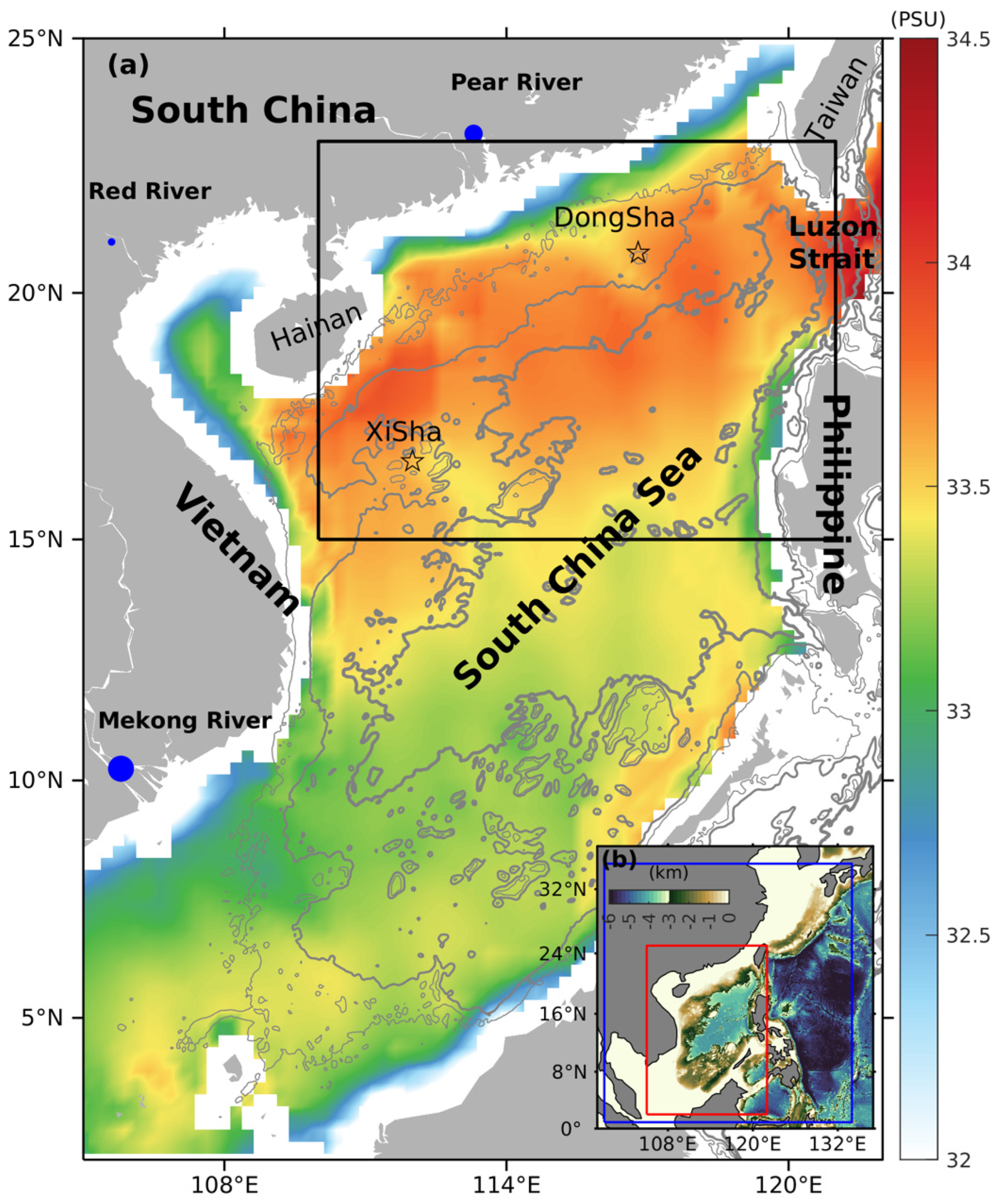
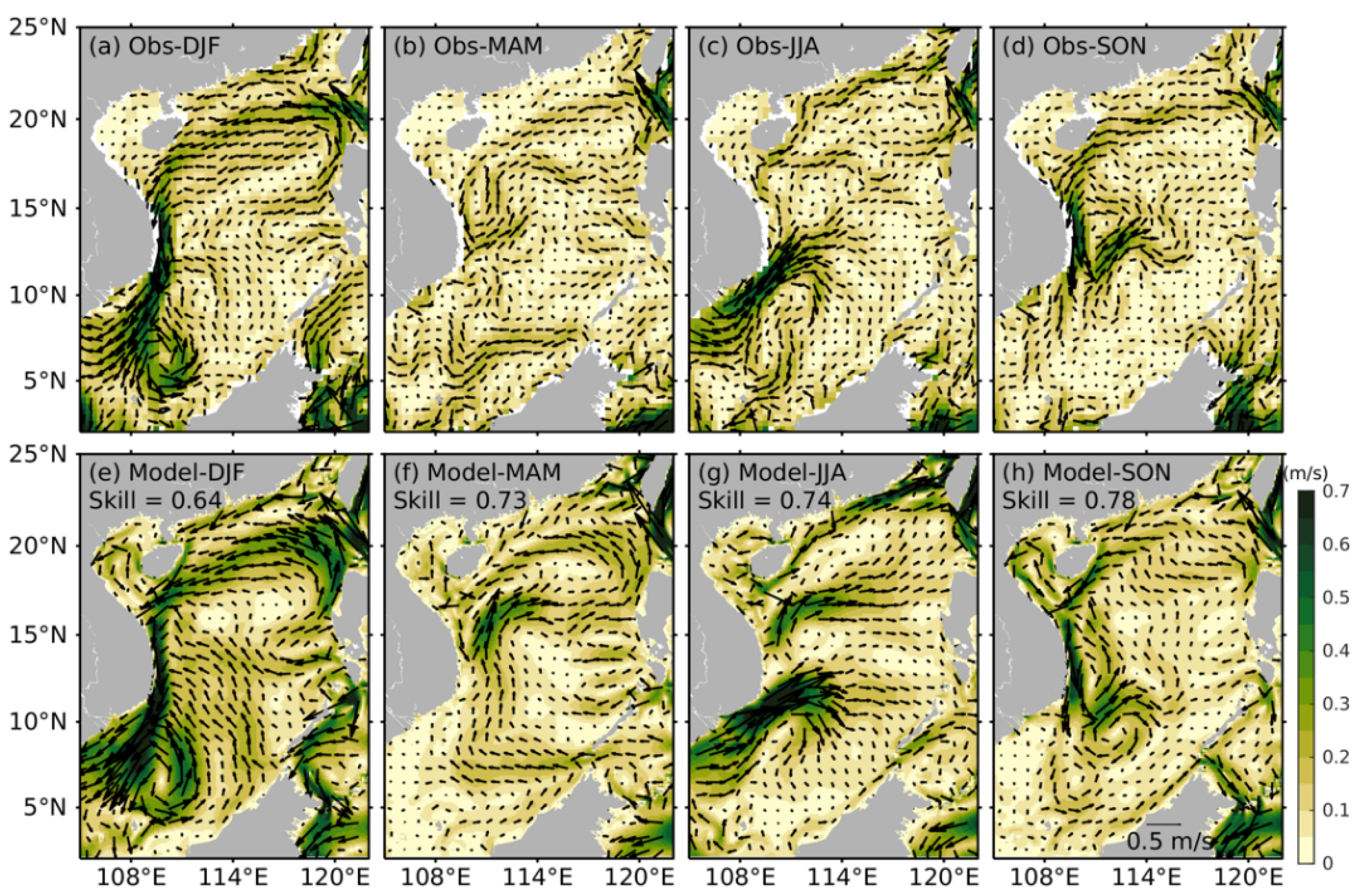
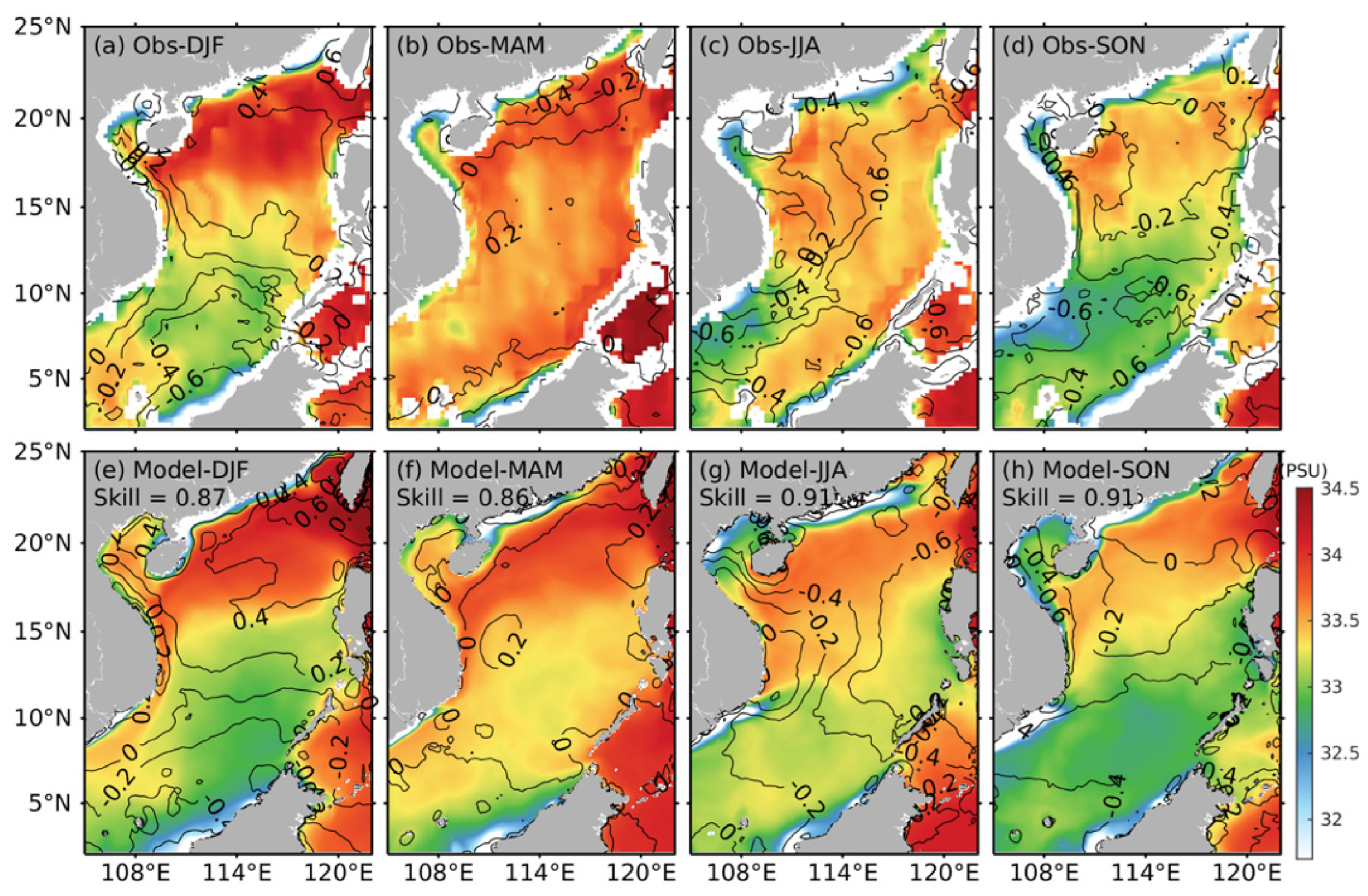
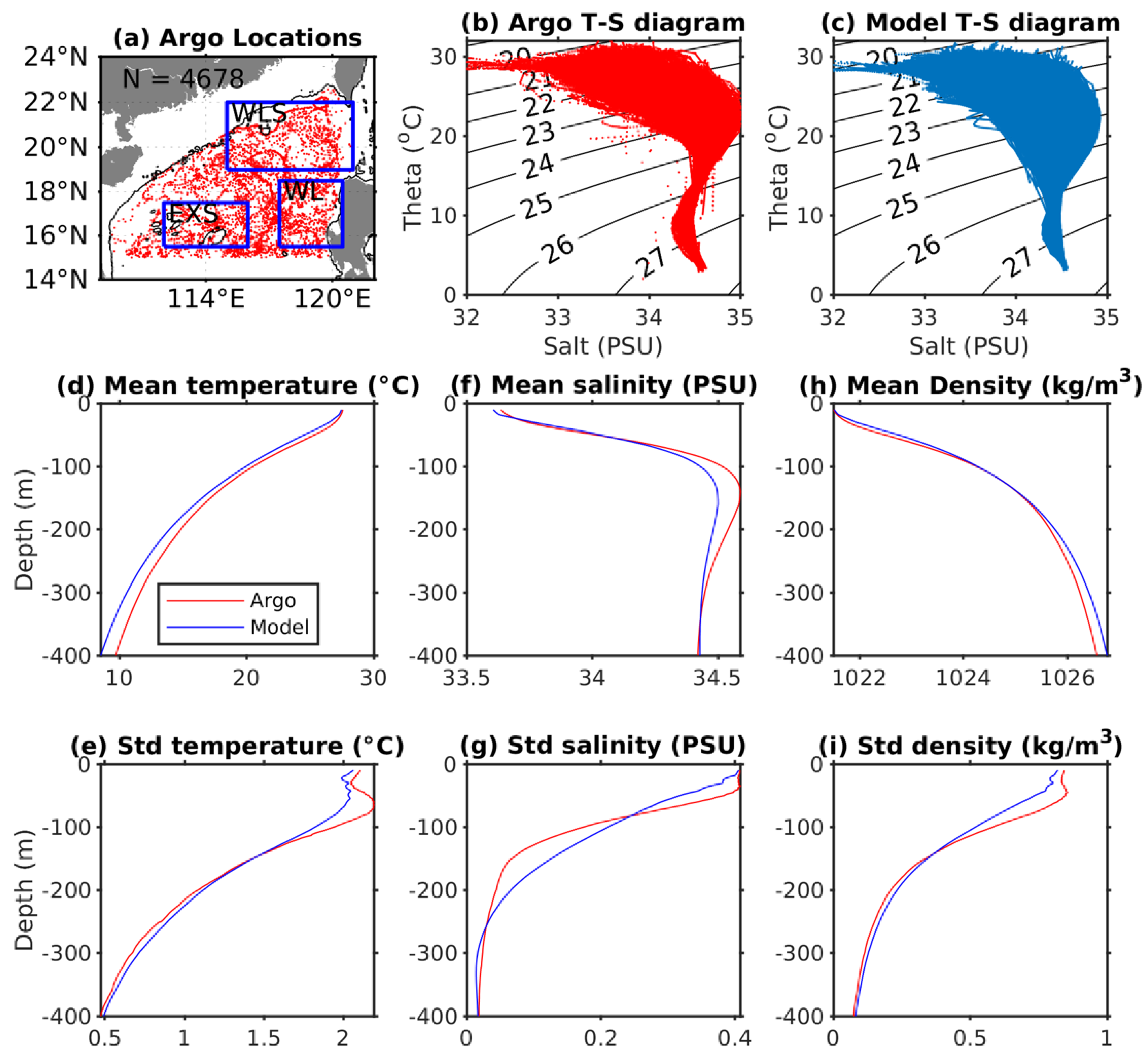
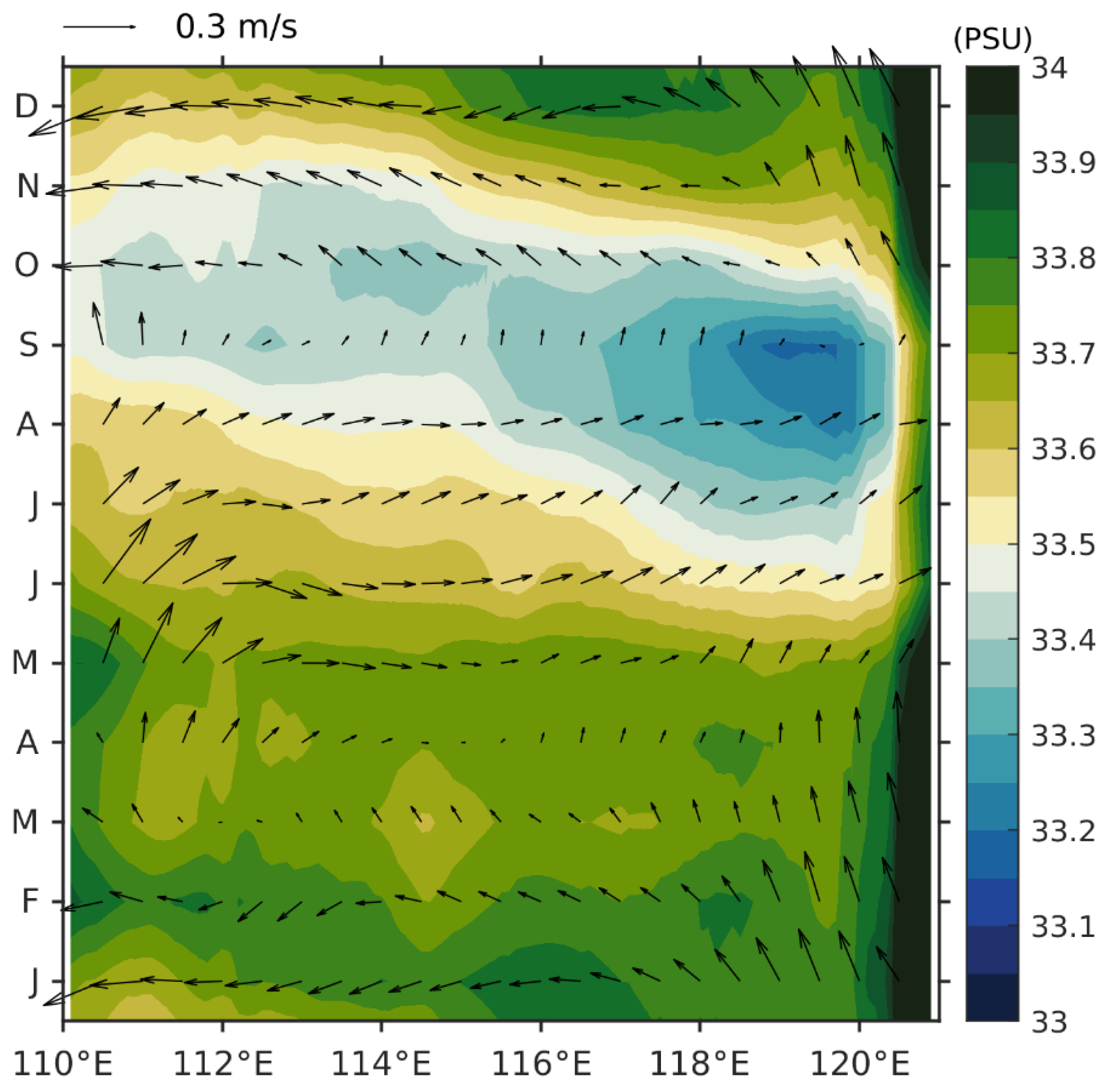
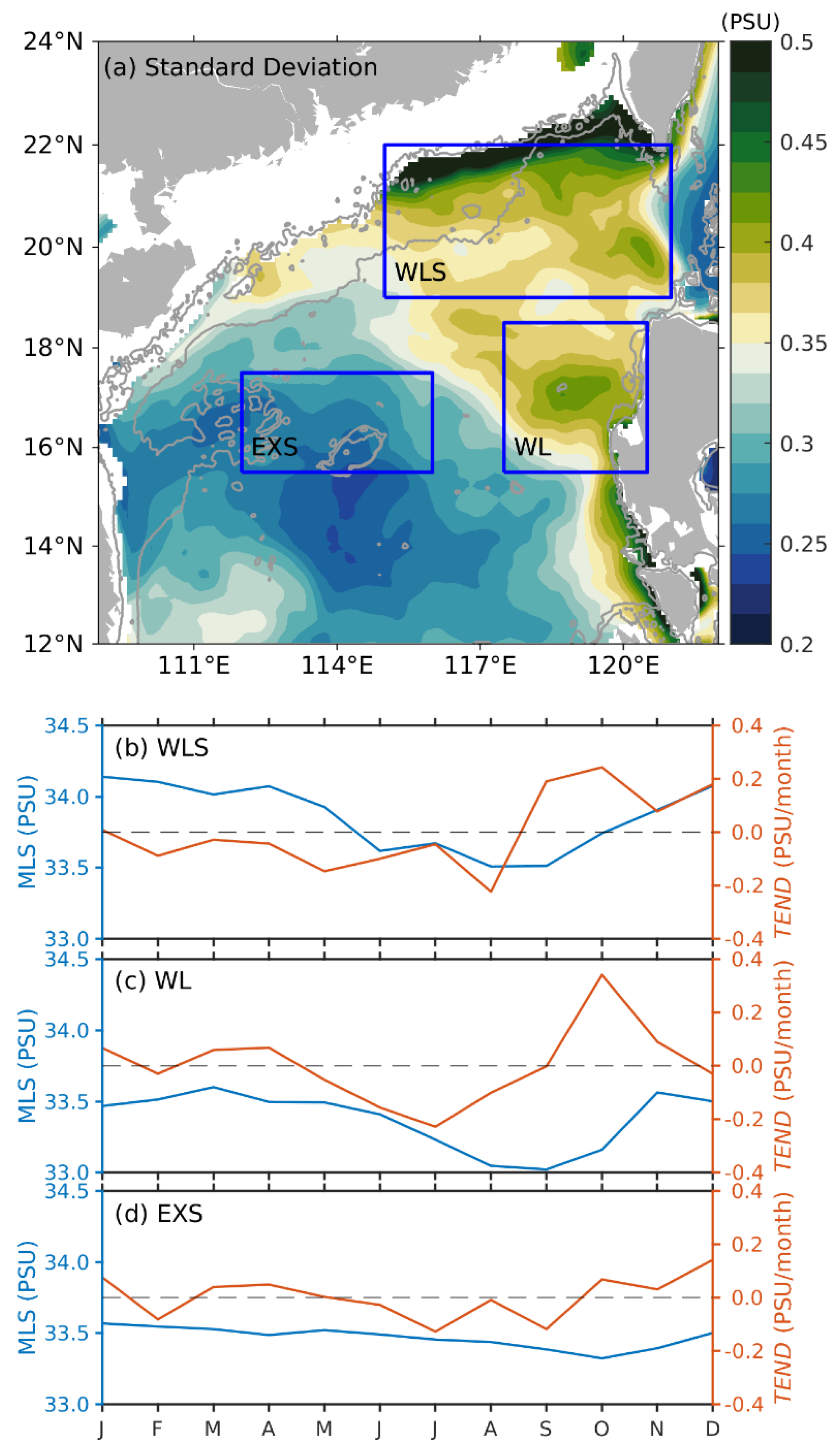
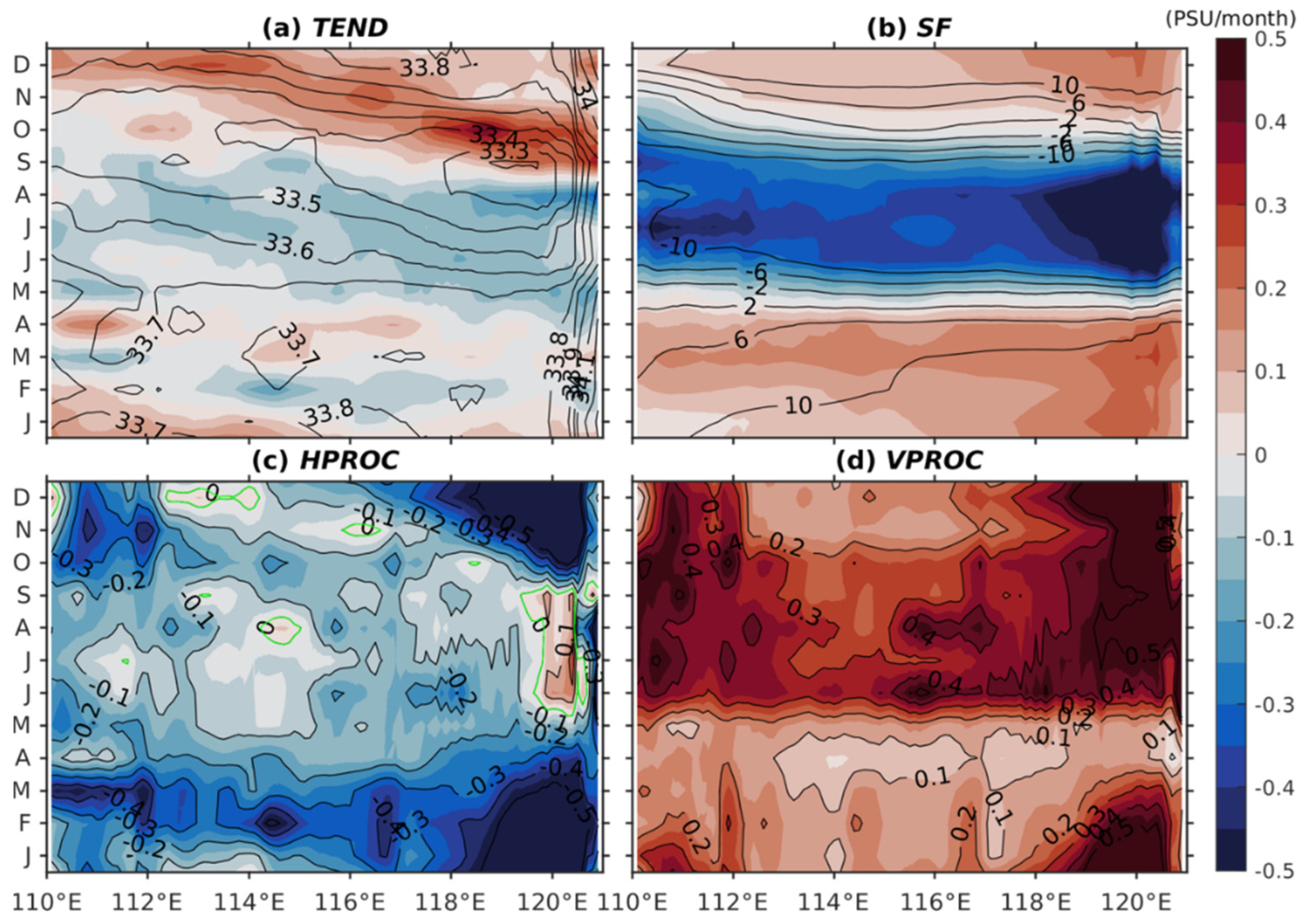

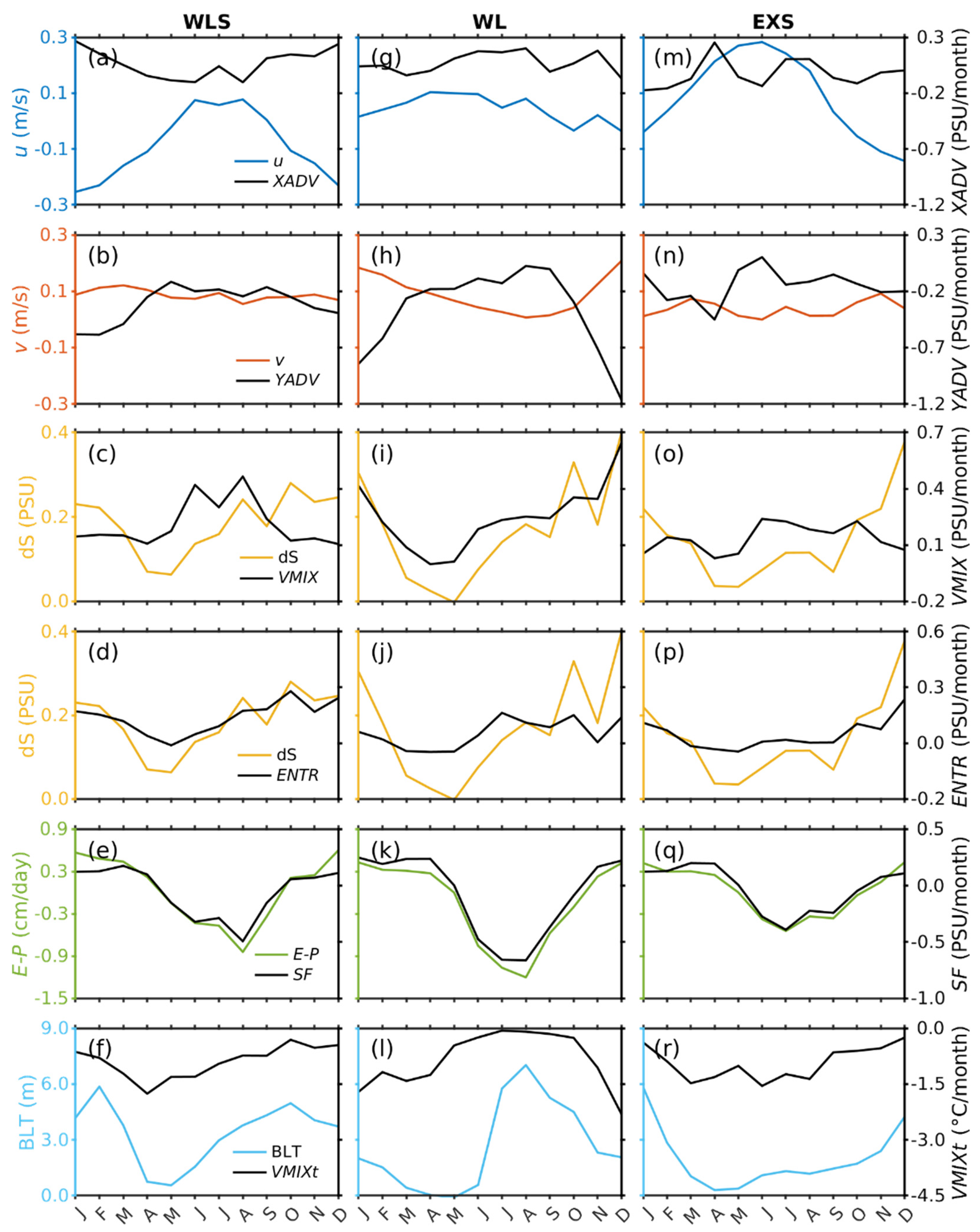
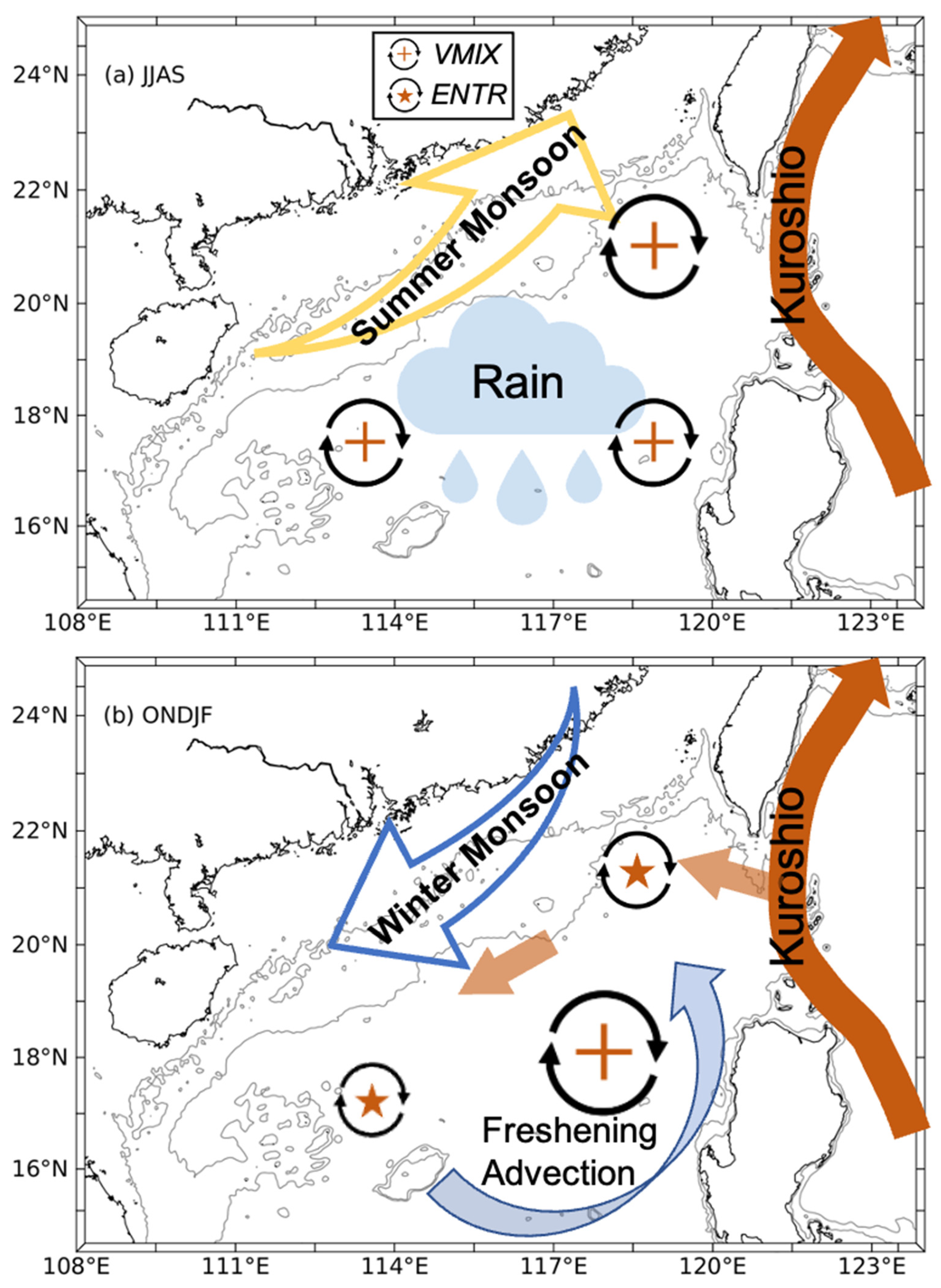
| Region | Num | Mean Obs | Mean Model | Bias | RMSE | Skill |
|---|---|---|---|---|---|---|
| WLS | 869 | 38.74 | 35.41 | −9.0% | 9.76 | 0.94 |
| WL | 628 | 32.95 | 26.40 | −20.0% | 10.11 | 0.73 |
| EXS | 461 | 34.31 | 28.95 | −16.0% | 10.31 | 0.77 |
Disclaimer/Publisher’s Note: The statements, opinions and data contained in all publications are solely those of the individual author(s) and contributor(s) and not of MDPI and/or the editor(s). MDPI and/or the editor(s) disclaim responsibility for any injury to people or property resulting from any ideas, methods, instructions or products referred to in the content. |
© 2023 by the authors. Licensee MDPI, Basel, Switzerland. This article is an open access article distributed under the terms and conditions of the Creative Commons Attribution (CC BY) license (https://creativecommons.org/licenses/by/4.0/).
Share and Cite
Chen, Y.; Xiao, C.; Zhang, Y.; Lai, Z. The Mixed Layer Salinity Budget in the Northern South China Sea: A Modeling Study. J. Mar. Sci. Eng. 2023, 11, 1693. https://doi.org/10.3390/jmse11091693
Chen Y, Xiao C, Zhang Y, Lai Z. The Mixed Layer Salinity Budget in the Northern South China Sea: A Modeling Study. Journal of Marine Science and Engineering. 2023; 11(9):1693. https://doi.org/10.3390/jmse11091693
Chicago/Turabian StyleChen, Yong, Canbo Xiao, Yu Zhang, and Zhigang Lai. 2023. "The Mixed Layer Salinity Budget in the Northern South China Sea: A Modeling Study" Journal of Marine Science and Engineering 11, no. 9: 1693. https://doi.org/10.3390/jmse11091693
APA StyleChen, Y., Xiao, C., Zhang, Y., & Lai, Z. (2023). The Mixed Layer Salinity Budget in the Northern South China Sea: A Modeling Study. Journal of Marine Science and Engineering, 11(9), 1693. https://doi.org/10.3390/jmse11091693






